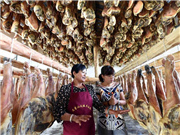

The 17 obligatory targets have all been achieved as planned. Among them, the target for rural land newly designated for construction and the target for land newly designated for construction as a whole are estimated to exceed the figures set at the beginning of the year. The main reasons for this are twofold:
First, during the post-earthquake efforts of recovery and reconstruction in Ludian, Yunnan, a portion of the land newly designated for construction was utilized in advance in accordance with the law, so the proper procedures for this land use will be made up for in accordance with regulations.
Second, in projects to link the amount of urban and rural land designated for construction to that of land returned to cultivation and in the efforts to reclaim land from deserted industrial and mining areas, part of the quota for land newly designated for construction was used to build housing for displaced rural residents. After reclamation of the abovementioned deserted areas is completed, that land will be used to offset the part of land newly designated for construction that was requisitioned for rural residents.
The overall performance of the 40 anticipatory targets was in line with or better than expectations, but some of them fell short of the planned figures. It should be noted that anticipatory targets are not predicted figures; they are development objectives that the country hopes to achieve and are a reflection of its policy orientation. The actual performance of these targets may be higher or lower than projected figures. There are many cases of discrepancies between the performance of targets and the figures projected.
First, some targets themselves are ceilings, so it is normal that actual performance of such targets may be lower than the targeted figures. An example of this is the target for the CPI.
Second, some targets are set a little higher than estimated figures in order to reflect the orientation of macro-control policies, with the growth rate of retail sales of consumer goods being one such target. The actual performance of these targets might vary a certain amount from targeted figures.
Third, some targets being lower than expected is due to unique factors. For instance, because the size of China’s economy increased after the third national economic census, the target for R&D spending as a percentage of GDP was slightly lower than projected figure.
Fourth, uncontrollable factors such as changes in the domestic or international economic environment may cause the actual figures of some targets to be lower than projected. An example of this is how the sharp drop in the prices of major commodities in the international market has caused the growth rate in the total volume of US dollar-denominated imports and exports to be slower than expected.
In short, in the face of complex international political and economic situations and an increasing number of new problems and new challenges in China’s development, the achievements that China has made thus far in economic and social development have not come easily. They are the result of the correct leadership of the Party Central Committee and the State Council, as well as the concerted efforts of all regions, all departments, and the people of all our ethnic groups, and should all the more be fully recognized and cherished.
At the same time, we should also be keenly aware that world politics, the economy, and geopolitics are closely intertwined; the global economy is still under profound adjustment following the international financial crisis, and overall, it continues to recover slowly.
Domestically, the long-standing problems of unbalanced, uncoordinated, and unsustainable development remain unresolved; in its current stage of development, China has to simultaneously deal with the slowdown in economic growth, make difficult structural adjustments, and absorb the effects of previous economic stimulus policies; and there are many difficulties and challenges facing the economy.
First, downward pressure on economic growth is building up. Growth in investment, which plays a key role in ensuring economic growth, has continued to slow back down; consumer demand is having a difficult time making significant increases; foreign demand is unlikely to change for the better; and new growth areas in consumer spending have not yet been able to fill the gaps left by old ones.
Second, some enterprises are having difficulties in production and operations. The output producer price index (PPI) has continued to fall; the expectation of deflation is getting stronger; the cost of factors of production such as capital and labor is increasing; there are still problems in the flow of credit funds to the real economy; the problem of small and micro businesses obtaining financing only at great effort and high cost has not been fundamentally alleviated; and enterprise profits have dropped markedly, affecting their confidence in the near-future market and producing a non-trivial ripple effect on employment and people’s income.
Third, there is overcapacity in traditional industries and a lack of effective supply in emerging industries. Resolving the problem of overcapacity is an arduous task that will increase pressure on society. There are too many restrictions upon entering into emerging industries and modern services, and there is a clear lack of effective supply of some goods or services for which there is a huge demand in the domestic market.
Fourth, it is becoming more difficult to remove hidden barriers and break vested interests when tackling the hard problems in reform. As China’s reform is at a critical stage and in a deep-water zone, deepening reform will involve more complicated conflicts and affect more deep-rooted interests. Some reform plans need further improvement, and the implementation of some reform measures is far from satisfactory.
Fifth, potential risks in some areas need our close attention. Adjustments to the real estate market face major uncertainties; different trends have emerged in the market; credit defaults have appeared in some enterprises; the amount of bad debt reported by banks has increased; and economic risks are emerging.
In addition, new problems have also cropped up in agriculture, foreign trade, social work, people’s wellbeing, ecological progress, environmental protection, and workplace safety.
Faced with these issues, we must keep a clear head and become more aware of any possible crisis and the bottom line, then work hard to respond to and resolve them.
 |  |
Day|Week

 Tsinghua junior makes over 10,000 yuan a day by selling alumnae's used quilts
Tsinghua junior makes over 10,000 yuan a day by selling alumnae's used quilts Graduation photos of students from Zhongnan University
Graduation photos of students from Zhongnan University A school with only one teacher in deep mountains
A school with only one teacher in deep mountains Glimpse of cultural heritage "Xilankapu"
Glimpse of cultural heritage "Xilankapu" Homemade cured hams in SW China
Homemade cured hams in SW China Breathtaking buildings of W. Sichuan Plateau
Breathtaking buildings of W. Sichuan Plateau Graduation photos of "legal beauties"
Graduation photos of "legal beauties" Top 10 most expensive restaurants in Beijing in 2015
Top 10 most expensive restaurants in Beijing in 2015